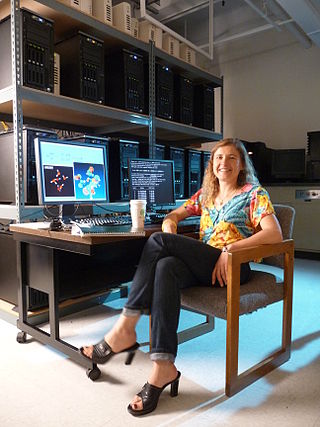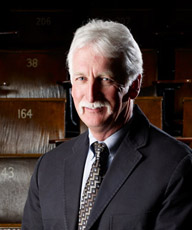
Computational chemistry is a branch of chemistry that uses computer simulations to assist in solving chemical problems. It uses methods of theoretical chemistry incorporated into computer programs to calculate the structures and properties of molecules, groups of molecules, and solids. The importance of this subject stems from the fact that, with the exception of some relatively recent findings related to the hydrogen molecular ion, achieving an accurate quantum mechanical depiction of chemical systems analytically, or in a closed form, is not feasible. The complexity inherent in the many-body problem exacerbates the challenge of providing detailed descriptions of quantum mechanical systems. While computational results normally complement information obtained by chemical experiments, it can occasionally predict unobserved chemical phenomena.

Molecular mechanics uses classical mechanics to model molecular systems. The Born–Oppenheimer approximation is assumed valid and the potential energy of all systems is calculated as a function of the nuclear coordinates using force fields. Molecular mechanics can be used to study molecule systems ranging in size and complexity from small to large biological systems or material assemblies with many thousands to millions of atoms.

Drug design, often referred to as rational drug design or simply rational design, is the inventive process of finding new medications based on the knowledge of a biological target. The drug is most commonly an organic small molecule that activates or inhibits the function of a biomolecule such as a protein, which in turn results in a therapeutic benefit to the patient. In the most basic sense, drug design involves the design of molecules that are complementary in shape and charge to the biomolecular target with which they interact and therefore will bind to it. Drug design frequently but not necessarily relies on computer modeling techniques. This type of modeling is sometimes referred to as computer-aided drug design. Finally, drug design that relies on the knowledge of the three-dimensional structure of the biomolecular target is known as structure-based drug design. In addition to small molecules, biopharmaceuticals including peptides and especially therapeutic antibodies are an increasingly important class of drugs and computational methods for improving the affinity, selectivity, and stability of these protein-based therapeutics have also been developed.

In the context of chemistry, molecular physics and physical chemistry and molecular modelling, a force field is a computational model that is used to describe the forces between atoms within molecules or between molecules as well as in crystals. Force fields are a variety of interatomic potentials. More precisely, the force field refers to the functional form and parameter sets used to calculate the potential energy of a system of the atomistic level. Force fields are usually used in molecular dynamics or Monte Carlo simulations. The parameters for a chosen energy function may be derived from classical laboratory experiment data, calculations in quantum mechanics, or both. Force fields utilize the same concept as force fields in classical physics, with the main difference that the force field parameters in chemistry describe the energy landscape on the atomistic level. From a force field, the acting forces on every particle are derived as a gradient of the potential energy with respect to the particle coordinates.

Kendall Newcomb Houk is a Distinguished Research Professor in Organic Chemistry at the University of California, Los Angeles. His research group studies organic, organometallic, and biological reactions using the tools of computational chemistry. This work involves quantum mechanical calculations, often with density functional theory, and molecular dynamics, either quantum dynamics for small systems or force fields such as AMBER, for solution and protein simulations.
Eamonn Francis Healy is an Irish-American professor of chemistry, organic chemistry, and biochemistry at St. Edward's University in Austin, Texas, where his research focuses on the design of structure-activity probes to elucidate enzymatic activity. Targets include HIV-1 integrase, the c-Kit and src-abl proteins, and the metalloproteinases associated with CXCL16 shedding.

Anna Igorevna Krylov is the USC Associates Chair in Natural Sciences and Professor of Chemistry at the University of Southern California (USC). Working in the field of theoretical and computational quantum chemistry, she is the inventor of the spin-flip method. Krylov is the president of Q-Chem, Inc. and an elected member of the International Academy of Quantum Molecular Science, the Academia Europaea, and the American Academy of Sciences and Letters.
Free-energy perturbation (FEP) is a method based on statistical mechanics that is used in computational chemistry for computing free-energy differences from molecular dynamics or Metropolis Monte Carlo simulations.

Arieh Warshel is an Israeli-American biochemist and biophysicist. He is a pioneer in computational studies on functional properties of biological molecules, Distinguished Professor of Chemistry and Biochemistry, and holds the Dana and David Dornsife Chair in Chemistry at the University of Southern California. He received the 2013 Nobel Prize in Chemistry, together with Michael Levitt and Martin Karplus for "the development of multiscale models for complex chemical systems".
Biochemical and Organic Simulation System (BOSS) is a general-purpose molecular modeling program that performs molecular mechanics calculations, Metropolis Monte Carlo statistical mechanics simulations, and semiempirical Austin Model 1 (AM1), PM3, and PDDG/PM3 quantum mechanics calculations. The molecular mechanics calculations cover energy minimizations, normal mode analysis and conformational searching with the Optimized Potentials for Liquid Simulations (OPLS) force fields. BOSS is developed by Prof. William L. Jorgensen at Yale University, and distributed commercially by Cemcomco, LLC and Schrödinger, Inc.

Ascalaph Designer is a computer program for general purpose molecular modelling for molecular design and simulations. It provides a graphical environment for the common programs of quantum and classical molecular modelling ORCA, NWChem, Firefly, CP2K and MDynaMix . The molecular mechanics calculations cover model building, energy optimizations and molecular dynamics. Firefly covers a wide range of quantum chemistry methods. Ascalaph Designer is free and open-source software, released under the GNU General Public License, version 2 (GPLv2).
Angela K. Wilson is an American scientist and former (2022) President of the American Chemical Society. She currently serves as the John A. Hannah Distinguished Professor of Chemistry, associate dean for strategic initiatives in the College of Natural Sciences, and director of the MSU Center for Quantum Computing, Science, and Engineering (MSU-Q) at Michigan State University.
TeraChem is a computational chemistry software program designed for CUDA-enabled Nvidia GPUs. The initial development started at the University of Illinois at Urbana-Champaign and was subsequently commercialized. It is currently distributed by PetaChem, LLC, located in Silicon Valley. As of 2020, the software package is still under active development.

Donald Gene Truhlar is an American scientist working in theoretical and computational chemistry and chemical physics with special emphases on quantum mechanics and chemical dynamics.
John C. Tully is a theoretical chemist, a researcher and Sterling Professor emeritus of Chemistry at Yale University. He is known for his development of surface hopping, a method for including excited states in molecular dynamics calculations. Much of his career was spent at Bell Labs, from 1970-1996, exploring theoretical chemistry and surface science. In 1996, he became a faculty member at Yale University, where he pursued research in physical chemistry and physics. He is a member of the National Academy of Sciences and the International Academy of Quantum Molecular Science. In 2020 he was awarded the NAS Award in Chemical Sciences.
Sharon Hammes-Schiffer is a physical chemist who has contributed to theoretical and computational chemistry. She is currently a Sterling Professor of Chemistry at Yale University. She has served as senior editor and deputy editor of the Journal of Physical Chemistry and advisory editor for Theoretical Chemistry Accounts. As of 1 January 2015 she is editor-in-chief of Chemical Reviews.
Kenneth M. Merz Jr. is an American biochemist and molecular biologist currently the Joseph Zichis Chair and a distinguished university professor at Michigan State University and editor-in-chief of American Chemical Society's Journal of Chemical Information and Modeling. A highly cited expert in his field, his research interests are in computational chemistry and biology and computer-aided drug design (CADD). His group has been involved in developing the widely using AMBER suite of programs for simulating chemical and biological systems and the QUICK program for quantum chemical calculations.
Anastassia N. Alexandrova is an American chemist who is a professor at the University of California, Los Angeles. Her research considers the computational design of functional materials.
Alexander D. MacKerell, Jr. is an American biophysicist who is the Grollman-Glick Professor of Pharmaceutical Sciences at the University of Maryland, Baltimore (UMB) and the Director of the Computer-Aided Drug Design (CADD) Center at UMB. He is also the Co-Founder and Chief Scientific Officer of the drug design tech company SilcsBio. In 2022, MacKerell was awarded the prestigious American Chemical Society Award for Computers in Chemical and Pharmaceutical Research.









